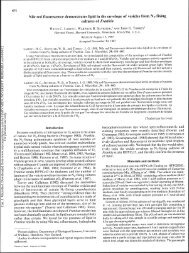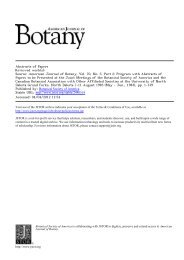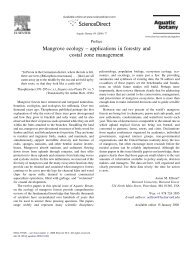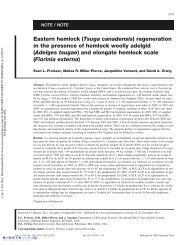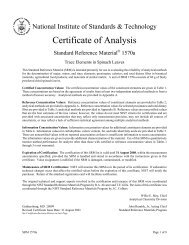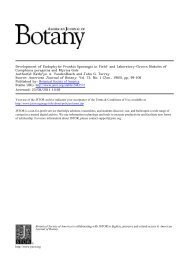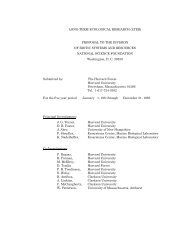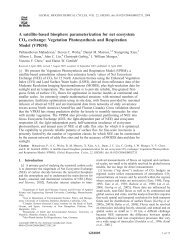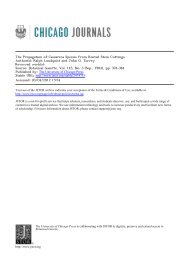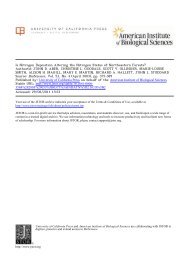Comparative Anatomy of Endogenous Bud and Lateral Root ...
Comparative Anatomy of Endogenous Bud and Lateral Root ...
Comparative Anatomy of Endogenous Bud and Lateral Root ...
Create successful ePaper yourself
Turn your PDF publications into a flip-book with our unique Google optimized e-Paper software.
498 AMERICAN JOURNAL OF BOTANY [ Vol. 53<br />
in segments cleared by the method <strong>of</strong> Jacobs<br />
(1952) organs could be distinguished before they do<br />
protruded from the root epidermis. It was found<br />
that buds could be distinguished from roots by<br />
the following features: (1) buds are broader<br />
organs than roots; (2) the terminal protoxylem<br />
elements <strong>of</strong> one primary root xylem pole become<br />
separated from the rest <strong>of</strong> the xylem elements in<br />
that pole during bud formation, <strong>and</strong> in a longitudinal<br />
view these protoxylem elements appear<br />
to form arcs which run through portions <strong>of</strong> the bud<br />
primordium; (3) the first xylem <strong>of</strong> the lateral root<br />
differentiates at right angles to the xylem <strong>of</strong> the<br />
parent root segment, whereas the first xylem <strong>of</strong><br />
the bud develops obliquely with respect to the<br />
parent xylem. These characteristics are illustrated<br />
in Fig. 1-4. Figure I shows a longitudinal<br />
view <strong>of</strong> a root segment with a cleared bud illustrating<br />
the raised terminal protoxylem elements<br />
running through the middle <strong>of</strong> the bud. Figure 2<br />
shows a bud in which some new xylem has differentiated.<br />
Figure 3 shows a cleared lateral root;<br />
Fig. 4 shows a more highly magnified view <strong>of</strong> the<br />
first mature xylem elements <strong>of</strong> the' lateral root.<br />
The pattern <strong>of</strong> xylem differentiation was adopted<br />
as the most important <strong>of</strong> these criteria, <strong>and</strong><br />
unless otherwise noted, primordia were not<br />
recorded unless they could be positively identified<br />
on this basis.<br />
Figure 5 shows the composite distribution <strong>of</strong><br />
organs formed in 30 segments 15 mm long, excised<br />
from the region <strong>of</strong> the root axis 15-165 mm from<br />
the root apex <strong>and</strong> cleared after 6 weeks in culture.<br />
The distribution <strong>of</strong> organs indicates that<br />
proximal3 regions <strong>of</strong> the segment, which do not<br />
I The terms "proximal" <strong>and</strong> "distal" refer to the segment<br />
orientation with respect to the root from which it was<br />
excised. The distal end <strong>of</strong> a segment is the end which was<br />
closest to the root tip, <strong>and</strong> the proximal end is the end<br />
which was farthest from the root tip.<br />
20<br />
AVE. NO. BUDS/SEGMENT: 2.97<br />
015-<br />
IL<br />
0<br />
w<br />
o-<br />
0<br />
w tO<br />
0-<br />
Z 15.<br />
20<br />
AVE. NOL ROOTS/SEGMENT: 1.23<br />
Fig. 5. The distribution <strong>of</strong> buds <strong>and</strong> roots in 30 segments,<br />
15 mm long, cultured for six weeks, cleared, <strong>and</strong><br />
counted. Each bar represents the total number <strong>of</strong> buds or<br />
roots recorded in each 1-mm interval.<br />
form roots, but which do have a high probability<br />
<strong>of</strong> forming buds can be excised. Distal regions, on<br />
the other h<strong>and</strong>, have a high probability <strong>of</strong> forming<br />
roots <strong>and</strong> also form a few buds.<br />
This polarity <strong>of</strong> organ formation, observed in<br />
cleared root segments, aided in the anatomical<br />
investigation <strong>of</strong> bud <strong>and</strong> root formation. Six root<br />
segments, 15 mm long, were excised from isolated<br />
roots grown in culture for about 6 weeks. The portion<br />
<strong>of</strong> the root axis used was the region 15-105<br />
mm from the root apex. The segments were placed<br />
in a petri plate, each with its distal end to the<br />
periphery <strong>of</strong> the plate. At varying time intervals<br />
after excision, 3-mm segments were excised from<br />
the proximal <strong>and</strong> the distal end <strong>of</strong> a segment <strong>and</strong><br />
examined for stages in the formation <strong>of</strong> buds <strong>and</strong><br />
Fig. 1-4.-Fig. 1. <strong>Lateral</strong> view <strong>of</strong> a cleared bud not yet protruding from the root segment. The overlying epidermis<br />
<strong>and</strong> cortex <strong>of</strong> the root have been removed. Terminal protoxylem elements <strong>of</strong> one xylem arm have been separated <strong>and</strong><br />
raised from the rest <strong>of</strong> the xylem elements, traversing the middle <strong>of</strong> the bud (unlabeled arrow). Photographed in polarized<br />
light, X95.-Fig. 2. <strong>Lateral</strong> view <strong>of</strong> a cleared bud not yet protruding from the root segment. The overlving epidermis<br />
<strong>of</strong> the root has been removed. The first xylem to differentiate in association with the bud is marked by arrows. The<br />
raised protoxylem elements are in another focal plane, X 125.-Fig. 3. Cleared lateral root protruding from the cortex<br />
<strong>of</strong> the parent root showing the first mature xylem <strong>of</strong> the lateral root. The overlying epidermis <strong>of</strong> the parent root has been<br />
removed. Photographed in dark field illumination, X90.-Fig. 4. Higher magnification <strong>of</strong> the lateral root-parent root<br />
junction showing the first mature xylem elements <strong>of</strong> two poles <strong>of</strong> the lateral root (unlabeled arrow). Terminal protoxylem<br />
elements <strong>of</strong> the xylem arm <strong>of</strong> the parent root remain adjacent to the rest <strong>of</strong> the xylem elements in that pole. Photographed<br />
in phase contrast, X240.<br />
Fig. 6-11.-Fig. 6. Transection <strong>of</strong> a root showing the primary tissues in the region <strong>of</strong> a xylem pole. px, protoxylem;<br />
p, pericycle; e, endodermis; c, cortex, X520.-Fig. 7-11. Transections near the distal end <strong>of</strong> root segments. e, endodermis.<br />
-Fig. 7. The same region shown in Fig. 6-24 hours after excision <strong>of</strong> the segment. Pericycle cells have undergone<br />
tangential division. Photographed in phase contrast, X505.-Fig. 8. A primordium 36 hours after excision. Outer<br />
daughter cells resulting from the first pericycle division have divided tangentially a second time. Photographed in phase<br />
contrast, X360.-Fig. 9. <strong>Root</strong> primordium 44 hours after excision <strong>of</strong> the segment. Radial files <strong>of</strong> four cells derived from<br />
the pericycle have formed. The outermost cells have undergone tangential enlargement <strong>and</strong> divided radially. Some<br />
endodermal cells have divided radially. Photographed in phase contrast, X385.-Fig. 10. <strong>Root</strong> primordium 60 hours<br />
after excision <strong>of</strong> the segment. Divisions <strong>of</strong> the endodermal cells have continued, resulting in two layers <strong>of</strong> cells. Cortical<br />
cells contiguous with the primordium have collapsed, X290.-Fig. 11. <strong>Root</strong> primordium 60 hours after excision <strong>of</strong> the<br />
segment. Cells derived from the endodermis have formed a triple layer at one point (unlabeled arrow). Cells contiguous<br />
with the primordium have collapsed, X260.




